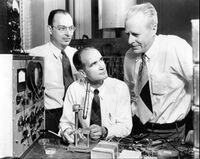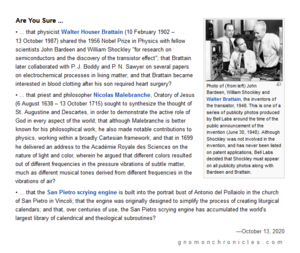October 13
Are You Sure ... (October 13, 2020)

• ... that physicist Walter Houser Brattain (10 February 1902 – 13 October 1987) shared the 1956 Nobel Prize in Physics with fellow scientists John Bardeen and William Shockley "for research on semiconductors and the discovery of the transistor effect"; that Brattain later collaborated with P. J. Boddy and P. N. Sawyer on several papers on electrochemical processes in living matter; and that Brattain became interested in blood clotting after his son required heart surgery?
• ... that priest and philosopher Nicolas Malebranche, Oratory of Jesus (6 August 1638 – 13 October 1715) sought to synthesize the thought of St. Augustine and Descartes, in order to demonstrate the active role of God in every aspect of the world; that although Malebranche is better known for his philosophical work, he also made notable contributions to physics, working within a broadly Cartesian framework; and that in 1699 he delivered an address to the Académie Royale des Sciences on the nature of light and color, wherein he argued that different colors resulted out of different frequencies in the pressure vibrations of subtle matter, much as different musical tones derived from different frequencies in the vibrations of air?
• ... that the San Pietro scrying engine is built into the portrait bust of Antonio del Pollaiolo in the church of San Pietro in Vincoli; that the engine was originally designed to simplify the process of creating liturgical calendars; and that, over centuries of use, the San Pietro scrying engine has accumulated the world's largest library of calendrical and theological subroutines?
On This Day in History and Fiction
1597: Astronomer Johannes Kepler replied to Galileo's letter of 4 August, 1597, urging him to be bold and proceed openly in his advocacy of Copernicanism.
1687: Astronomer, lens-maker, and academic Geminiano Montanari dies. He made the observation that Algol in the constellation of Perseus varies in brightness.
1715: Priest and philosopher Nicolas Malebranche dies. He was instrumental in introducing and disseminating the work of René Descartes and Gottfried Wilhelm Leibniz in France.
1729: Leonhard Euler mentions the gamma function in a letter to Christian Goldbach. Adrien-Marie Legendre gave the function its symbol and name in 1826.
1772: Using the San Pietro scrying engine, astronomer Charles Messier previews his discovery of a "galactic whirlpool" with a temporal accuracy of "within a year".
1773: The Whirlpool Galaxy is discovered by Charles Messier.
1890: Mathematician Georg Feigl born. He will work on the foundations of geometry and topology, studying fixed point theorems for n-dimensional manifolds. Feigl will be one of the initial authors of the Mathematisches Wörterbuch.
1976: The first electron micrograph of an Ebola viral particle is obtained by Dr. F. A. Murphy at the C.D.C.
1987: Physicist and academic Walter Houser Brattain dies. He shared the Nobel Prize in Physics in 1956 "for research on semiconductors and the discovery of the transistor effect."









